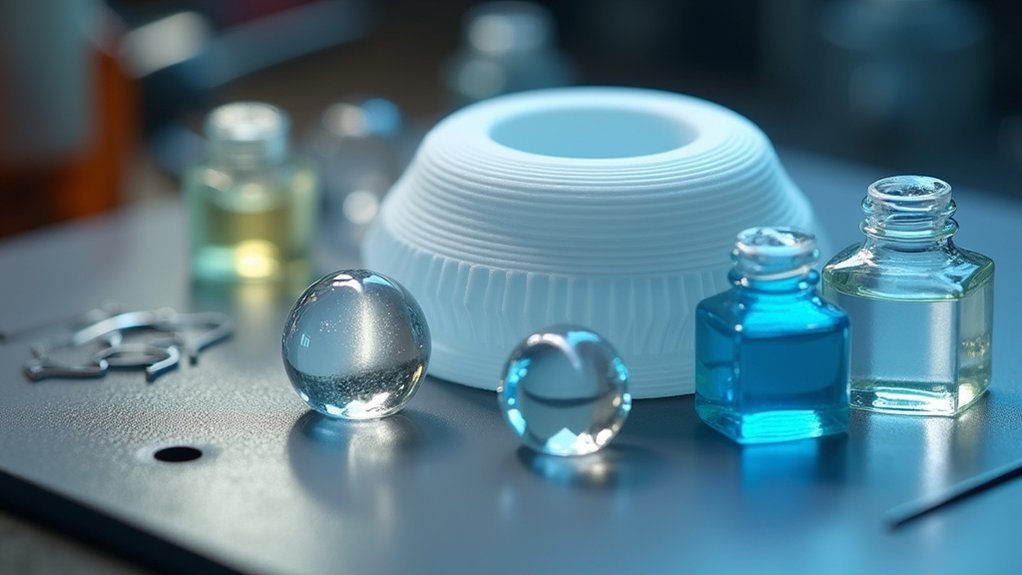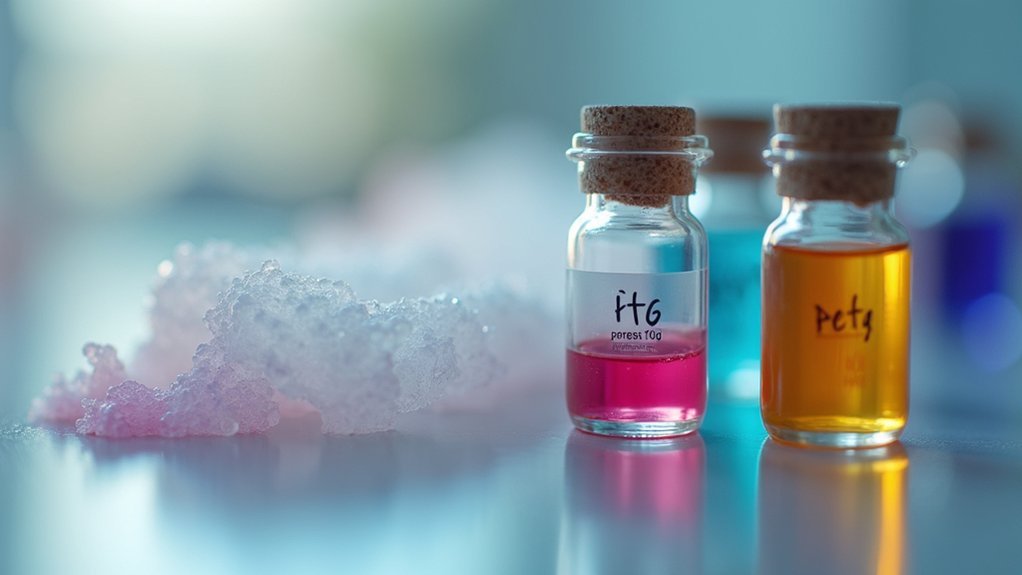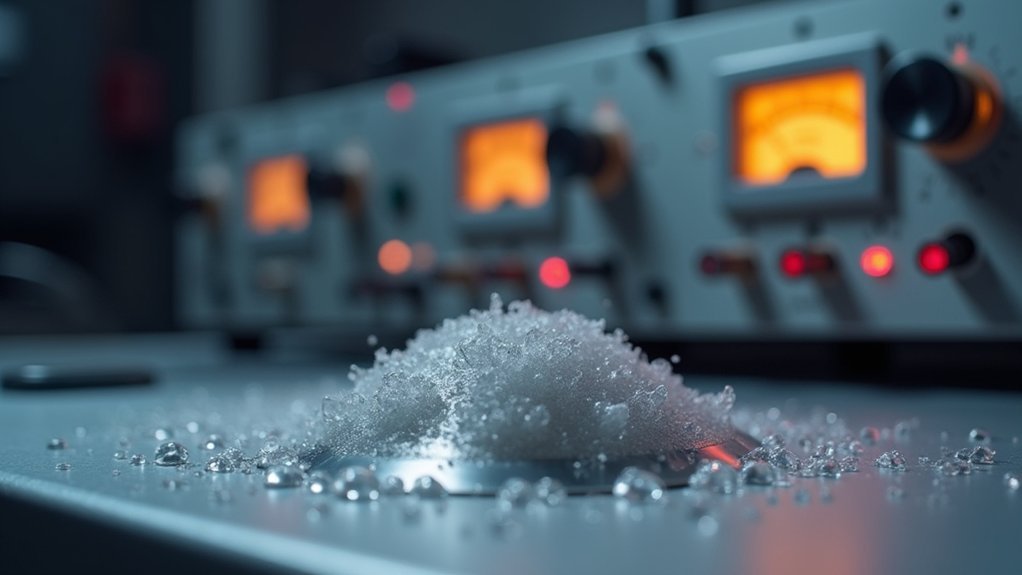You’ll achieve the smoothest finishes on your 3D printed parts by using material-specific chemical agents that dissolve surface layers. Dichloromethane works best for PETG materials, reducing surface roughness from over 250uin Ra to below 125uin Ra, though it requires extreme safety precautions due to toxicity. Acetone smooths ABS effectively, while isopropyl alcohol provides moderate results for various plastics. Always work in well-ventilated areas with proper protective equipment and controlled vapor chambers for ideal results and thorough technique mastery.
Understanding Chemical Smoothing for PETG Materials

While PETG offers excellent strength and clarity for 3D printing applications, you’ll find that achieving a perfectly smooth surface finish requires chemical smoothing techniques.
PETG’s exceptional durability and transparency make it ideal for demanding applications, though professional surface finishing techniques become necessary for optimal results.
Dichloromethane serves as the primary smoothing agent for PETG, effectively dissolving the surface layer to eliminate visible layer lines and enhance aesthetic appeal.
You’ll need to exercise extreme caution when using this method, as dichloromethane is heavily regulated due to its hazardous properties.
The chemical smoothing process requires longer exposure times for PETG compared to other materials, making careful monitoring essential to prevent deformation or structural damage.
Always work in well-ventilated areas and wear appropriate protective equipment.
Control vapor exposure carefully to maintain your prints’ integrity while achieving the desired surface finish improvement.
Safety Precautions When Working With Chemical Agents
When you’re working with chemical smoothing agents, you’ll need to establish proper ventilation in your workspace to prevent inhaling toxic fumes.
You must wear appropriate personal protective equipment including chemical-resistant gloves, safety glasses, and respiratory protection when handling solvents like acetone or dichloromethane.
You’ll also need to implement strict chemical storage protocols to keep these flammable and hazardous materials away from heat sources and in properly labeled, sealed containers.
Proper Ventilation Requirements
Since chemical smoothing agents like acetone release toxic and highly flammable fumes, you’ll need to establish proper ventilation before starting any smoothing project.
Work outdoors whenever possible, or choose indoor spaces equipped with exhaust fans that effectively disperse harmful vapors. Never work in enclosed areas without adequate airflow.
Your smoothing box shouldn’t be completely sealed. Include small holes or vents to prevent dangerous pressure buildup and allow fume escape. This prevents vapor concentration that could ignite or cause respiratory problems.
Install exhaust fans or open windows to maintain continuous air circulation. Monitor air quality regularly throughout the process.
Even with proper ventilation, wear protective equipment including gloves and face masks to minimize direct exposure to volatile organic solvents during chemical smoothing operations.
Personal Protective Equipment
Beyond establishing proper airflow in your workspace, you must equip yourself with the right protective gear to handle chemical smoothing agents safely.
Personal protective equipment forms your primary defense against chemical exposure and potential reactions.
Always wear chemical-resistant gloves to prevent skin irritation or absorption of harmful solvents. Use a properly fitted respirator or face mask to avoid inhaling dangerous fumes from volatile compounds like acetone and IPA.
Safety goggles or face shields protect your eyes from chemical splashes that can cause serious damage.
Keep a fire extinguisher rated for flammable liquids within reach, since many smoothing agents like acetone and d-limonene are highly flammable.
This combination of protective gear guarantees you can handle any unexpected chemical reaction safely.
Chemical Storage Protocols
Proper storage protocols become critical once you’ve acquired chemical smoothing agents, as improper handling can lead to dangerous accidents or environmental hazards.
You’ll need to store chemical agents in cool, well-ventilated areas away from direct sunlight and flammable materials to prevent ignition risks.
Use appropriately labeled, sealed containers that meet safety standards to avoid leaks and accidental exposure to harmful fumes.
Store volatile solvents like acetone and IPA in explosion-proof cabinets to minimize fire hazards.
Regularly inspect your storage areas for deterioration, leaks, or spills, and keep spill containment kits nearby.
Confirm safety data sheets for all chemicals remain accessible in the storage area for emergency procedures.
Dichloromethane: The Primary Smoothing Agent for PETG
When you’re looking to achieve professional-grade surface finishes on PETG prints, dichloromethane stands out as the most effective chemical smoothing agent available.
Also known as methylene chloride, this solvent works by dissolving PETG’s outer layer, allowing polymer chains to reorganize into a smoother texture. You’ll typically see surface roughness improvements from over 250uin Ra to below 125uin Ra through controlled vapor exposure.
However, you must handle dichloromethane with extreme caution due to its toxicity and flammability. Always work in well-ventilated spaces and wear appropriate protective equipment.
Before using this agent, check your local regulations for compliance requirements. While dichloromethane delivers exceptional smoothing results that enhance both aesthetics and surface quality, proper safety protocols aren’t optional—they’re essential for protecting your health during the smoothing process.
Alternative Chemical Solutions for PETG Smoothing

You’ll need to evaluate dichloromethane’s safety risks before using it on PETG, as it requires special handling and ventilation due to its toxic nature.
If you can’t access dichloromethane or prefer safer alternatives, you’ll find limited options since PETG resists most common solvents like acetone.
You can explore methylene chloride substitutes, though they’re often less effective and may still require careful application to prevent warping your prints.
Dichloromethane Safety Considerations
Although dichloromethane delivers excellent smoothing results for PETG prints, its classification as a hazardous chemical demands rigorous safety protocols that you can’t afford to ignore.
While DCM effectively removes surface imperfections, its carcinogenic properties and volatility pose serious health risks including respiratory issues and skin irritation.
You must wear appropriate PPE—gloves, goggles, and masks—when handling dichloromethane.
Work exclusively in well-ventilated areas or fume hoods to prevent dangerous inhalation.
Monitor your PETG parts carefully during exposure, as DCM can cause significant dimensional changes that’ll ruin your prints if left unchecked.
Disposal requires strict adherence to local environmental regulations.
The chemical’s adverse environmental effects make proper handling and disposal mandatory, not optional safety considerations.
Methylene Chloride Alternatives
Given these serious safety concerns with dichloromethane, safer alternatives can provide effective PETG smoothing without the extreme health risks.
While these substitutes won’t match methylene chloride’s rapid results or high-gloss surface finishes, they offer reasonable smoothing capabilities with considerably reduced hazards.
Here are four practical alternatives for PETG smoothing:
- Isopropyl alcohol (IPA) – Provides moderate smoothing but requires longer exposure times than methylene chloride.
- Ethyl acetate – Delivers decent results when used in controlled vapor exposure environments.
- Heat treatment – Offers chemical-free smoothing through careful temperature control.
- Mechanical polishing – Achieves smooth finishes using progressive grits without solvents.
You’ll need patience with these alternatives since they work slower, but they’re much safer for regular use in your workshop.
Vapor Chamber Setup and Equipment Requirements
When setting up a vapor chamber for chemical smoothing, you’ll need a sealed enclosure that contains solvent vapors while ensuring even exposure across your printed parts. Your chamber requires a heat source maintaining approximately 80°C for effective solvent vaporization.
| Equipment | Purpose |
|---|---|
| Heating Element | Maintains 80°C temperature |
| Hanging Mechanism | Suspends parts for even exposure |
| Ventilation System | Prevents pressure buildup |
Hang your parts inside the vapor chamber to maximize surface contact with vapors and prevent uneven smoothing from bottom contact. Don’t completely seal the chamber—incorporate tiny ventilation holes in the plastic cover for controlled vapor escape.
Essential safety equipment includes gloves and face protection. You’ll also need appropriate vapor finishing agents like acetone for ABS/ASA materials.
Optimal Process Parameters and Temperature Control

You’ll need to maintain precise temperature settings around 80°C for your heatbed to create ideal acetone vapor conditions.
Control your exposure time carefully, starting with 20-minute intervals while monitoring parts to prevent over-smoothing and distortion.
Manage chamber pressure by ensuring proper ventilation through small holes in your smoothing box to prevent dangerous buildup while containing fumes.
Temperature Settings Guidelines
Although temperature control might seem straightforward, achieving ideal results with chemical smoothing requires precise parameter management that can make or break your finished print. Your temperature settings directly impact how effectively acetone vapor penetrates and smooths your ABS/ASA parts during chemical smoothing.
Follow these critical temperature guidelines:
- Set your heatbed to 80°C – This creates favorable conditions for acetone vapor effectiveness.
- Monitor ambient temperature consistently – Fluctuations can cause uneven smoothing results.
- Allow gradual cooling – Rapid temperature changes can cause warping or cracking.
- Maintain stable heat throughout exposure – Temperature drops reduce vapor efficiency.
Remember that parts remain soft for several hours after chemical smoothing, so you’ll need to handle them carefully during the cooling phase to prevent deformation.
Exposure Time Control
Since temperature forms just one piece of the chemical smoothing puzzle, exposure time control serves as the other critical parameter that determines your print’s final quality.
You’ll want to start with acetone exposure for approximately 20 minutes, but don’t set a timer and walk away. Monitor your prints closely throughout the process to prevent over-smoothing that destroys fine details.
Large or intricate models need adjusted timing – they’re more susceptible to dimensional changes and detail loss. You must estimate submersion time accurately when using a smoothing box to avoid excessive exposure.
Remember that your prints stay soft for several hours after treatment, so handle them carefully during recovery. Proper exposure time control guarantees you’ll achieve that perfectly smoothed surface without compromising structural integrity.
Chamber Pressure Management
When vapor concentration builds up inside your smoothing chamber, proper pressure management becomes the determining factor between achieving professional results and ruining your print entirely.
You’ll need to control atmospheric conditions carefully to guarantee your smoothed surface develops evenly without warping or melting.
Effective chamber pressure management requires these essential steps:
- Don’t create a perfectly sealed chamber – allow controlled fume escape to prevent dangerous pressure buildup
- Install a light plastic plate with tiny holes on top of your smoothing box for regulated vapor release
- Monitor vapor concentration levels throughout the process to maintain consistent surface treatment
- Balance containment with ventilation to keep smoothing vapors active while preventing oversaturation
This approach guarantees ideal conditions for achieving consistently smooth finishes.
Application Methods: Vapor vs. Direct Chemical Contact
While chemical smoothing can dramatically improve your 3D prints’ surface quality, the method you choose to apply these agents will considerably impact your results.
Vapor smoothing introduces vaporized solvent into a sealed chamber, allowing it to condense on your part’s surface without direct contact. This method typically requires 20 minutes of exposure and effectively redistributes surface material, reducing peaks and valleys for superior uniformity.
Vapor smoothing uses vaporized solvent in a sealed chamber to redistribute surface material and achieve superior uniformity in 20 minutes.
Direct chemical contact methods involve brushing or submerging parts in solvents, but they’re less reliable. You’ll face challenges estimating proper submersion time and risk uneven results or print damage.
While both methods require safety precautions—proper ventilation for vapor smoothing and protective equipment for direct contact—vapor smoothing consistently delivers better surface quality with more predictable outcomes.
Material Selection: Choosing PETG Grades for Best Results
Your chemical smoothing success depends heavily on selecting the right PETG grade, as different formulations respond differently to solvents. The glycol modifications in various PETG types directly impact how your printed part reacts to smoothing agents, affecting both the process and final surface quality.
Consider these key factors for ideal material selection:
- Choose clear over opaque grades – Clear PETG typically achieves superior transparency and glossiness after smoothing treatment.
- Check additive compatibility – Some PETG formulations contain additives that react poorly with dichloromethane and other smoothing agents.
- Account for viscosity differences – Higher viscosity grades need longer exposure times to achieve desired results.
- Test before committing – Always run small sample tests to verify compatibility between your chosen PETG grade and smoothing agent.
Post-Processing Care and Handling of Smoothed Parts
Although chemical smoothing dramatically improves surface finish, the process doesn’t end when you remove parts from the solvent chamber. Proper post-processing care is essential for achieving that desired smoother surface while maintaining part integrity.
Chemical smoothing success depends on meticulous post-processing care to preserve surface quality and structural integrity.
You’ll need to handle smoothed parts carefully since they remain soft for several hours after treatment. Transfer them immediately to a clean box to prevent contamination and protect the finish. Guarantee adequate ventilation, as acetone smell can persist for days.
Be aware that intricate designs may experience minor geometrical changes or detail loss during smoothing. Always verify parts are fully cured and dry before use.
Premature handling can create surface imperfections and compromise mechanical properties. This careful approach guarantees best results from your chemical smoothing efforts.
Troubleshooting Common Chemical Smoothing Defects
Even with meticulous preparation, chemical smoothing can produce unexpected defects that compromise your print’s appearance and structural integrity. Understanding these issues helps you achieve the best smoothing effect while preserving critical features like sharp edges.
Common defects you’ll encounter include:
- Over-smoothing – Monitor exposure times closely, keeping ABS/ASA prints around 20 minutes to prevent detail loss and deformation.
- Under-smoothing – Increase vapor concentration and exposure time if visible layer lines persist after treatment.
- Uneven smoothing – Position parts strategically within your smoothing chamber to guarantee uniform vapor exposure.
- Distortion and warping – Reinforce large or thin models with supports, or modify designs to reduce exposed surface area.
Handle freshly smoothed parts carefully, as they remain soft for hours and easily accept fingerprints or marks.
Frequently Asked Questions
What Chemicals Are Best for Smoothing 3D Prints?
You’ll want acetone for ABS/ASA prints, isopropyl alcohol for PVB, d-limonene for HIPS, and dichloromethane for PETG. Avoid smoothing PLA since it’s difficult and requires dangerous chemicals.
How to Chemically Smooth 3D Prints?
You’ll expose your ABS/ASA prints to acetone vapors for twenty minutes in a controlled environment. Use IPA for PVB materials and d-limonene for HIPS. Always work in ventilated areas wearing protective equipment.
What Is the Best Solvent for PLA Smoothing?
You’ll find there isn’t an ideal solvent for PLA smoothing. Chloroform works but it’s hazardous and hard to get. You’re better off using mechanical methods like sanding for safer, more effective results.
Can You Smooth PLA With Isopropyl Alcohol?
You can’t effectively smooth PLA with isopropyl alcohol since PLA doesn’t dissolve well in IPA. You’ll get uneven results and potential damage. Try sanding or polishing instead for better smoothing outcomes.





Leave a Reply